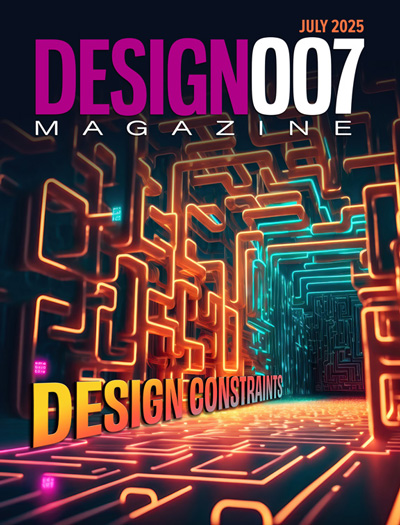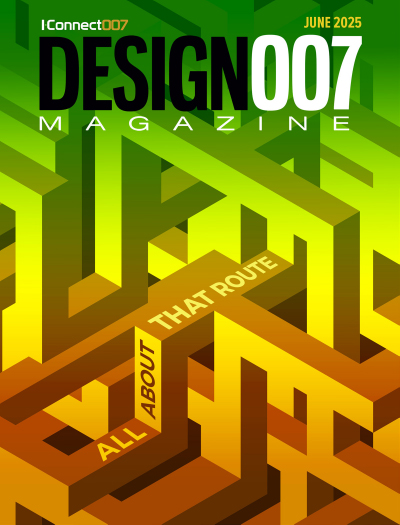-

- News
- Books
Featured Books
- design007 Magazine
Latest Issues
Current Issue
Proper Floor Planning
Floor planning decisions can make or break performance, manufacturability, and timelines. This month’s contributors weigh in with their best practices for proper floor planning and specific strategies to get it right.

Showing Some Constraint
A strong design constraint strategy carefully balances a wide range of electrical and manufacturing trade-offs. This month, we explore the key requirements, common challenges, and best practices behind building an effective constraint strategy.

All About That Route
Most designers favor manual routing, but today's interactive autorouters may be changing designers' minds by allowing users more direct control. In this issue, our expert contributors discuss a variety of manual and autorouting strategies.
- Articles
- Columns
- Links
- Media kit
||| MENU - design007 Magazine
The Future Is Electric
April 13, 2021 | KJ McCann and Brian Zirlin, Aurora CircuitsEstimated reading time: 2 minutes
Worldwide research and development of the automotive industry began as early as the 17th century and since then has taken several different design paths, with each country forging its own innovative trail and hundreds of prototypes emerging into the market. Vehicles—with steam-powered, electric, and combustion engines—began to play a major role, not only in the Industrial Revolution, but in everyday life. Although many believe that electric vehicles (EVs) are relatively new to the market, they have actually been around since 1832. Unfortunately, for the environment at least, gasoline-powered vehicles won the race as mass production, automatic starters, and cheaper oil prices gave them the upper hand. So, where did the major innovation for EVs truly begin?
While gasoline-powered engines emerged as the leading design, they were not without fault. For that reason, General Motors released its first electric car in 1996—the EV1—however, the push to bring this car to market was feeble, resulting in unfavorable outcomes. EV1s were sold solely through “limited lease-only agreements,” and only to residents of Los Angeles (California). The scant supply resulted in GM’s very selective and restrictive consumer bias. These cars often landed in the hands of the elite, making the idea of owning an EV unattainable to the average consumer. Ultimately, GM decided that electric cars were an unprofitable niche of the automobile market; this resulted in the company buying back and crushing most of its electric cars. The undoing of this product line led to an industry pullback from EVs as whole.
As years went by, automotive manufacturers failed to automate and mass produce, and the product line continued its downfall. The pushback on electric vehicles continued as the Bush Administration proposed $1.2 billion in research funding to develop clean, hydrogen-powered automobiles. The federal government joined the oil and car industry to push hydrogen fuel cell vehicles, knocking EVs a decade further away. Despite the strong pushback from car manufacturers to switch to EVs, Toyota moved forward, releasing its completely redesigned Prius in 2003. Finally, the consumer demand for EVs met market expectations. Consumer sales surpassed monthly sales targets more than 100%. But again, these vehicles were driven by the elite and high society celebrities. In 2006, Tesla Motors, a mere startup company from Silicon Valley, promised to deliver a vehicle with the luxury feel of a sports car, combined with a range of 200+ miles. In 2008, that dream became reality when Elon Musk, chairman of Tesla, debuted the first Tesla Roadster. This sent shock waves through the automaker industry as consumers flocked to EVs in greater numbers than expected.
To read this entire article, which appeared in the March 2021 issue of PCB007 Magazine, click here.
Testimonial
"Our marketing partnership with I-Connect007 is already delivering. Just a day after our press release went live, we received a direct inquiry about our updated products!"
Rachael Temple - AlltematedSuggested Items
I-Connect007 Editor’s Choice: Five Must-Reads for the Week
09/05/2025 | Andy Shaughnessy, I-Connect007It’s almost fall here in Atlanta, and that means that the temperature is finally dropping. And it quit raining! It’s been raining since March, and I’m so over it, as the social influencers say. Last night we grilled out on the deck, and it wasn’t hot, and we didn’t get rained on. Life is good. It was a busy week in the industry. In this installment of my must-reads, we say goodbye to Walt Custer, the man who made PCB data points interesting for the rest of us.
UHDI Fundamentals: UHDI Technology and Industry 4.0
09/03/2025 | Anaya Vardya, American Standard CircuitsUltra high density interconnect (UHDI) technology is rapidly transforming how smart systems are designed and deployed in the context of Industry 4.0. With its capacity to support highly miniaturized, high-performance, and densely packed electronics, UHDI is a critical enabler of the smart, connected, and automated industrial future. Here, I’ll explore the synergy between UHDI and Industry 4.0 technologies, highlighting applications, benefits, and future directions.
Nolan’s Notes: Everyone Has Their Eye on India
09/03/2025 | Nolan Johnson -- Column: Nolan's NotesIn this issue of SMT007 Magazine, we turn our attention to the Indian EMS market. We start with an interview with David Bergman, whose foresight in the early 2000s opened doors for the Global Electronics Association to begin helping Indian EMS companies with standards and certifications that would give EMS companies a footing to enter a global EMS market.
I-Connect007 Editor’s Choice: Five Must-Reads for the Week
08/29/2025 | Nolan Johnson, I-Connect007This week, we bring you Global Electronics Association’s Chris Mitchell’s government relations column on—you guessed it—trade deals. TTM is balancing its facilities between East and West. The Global Electronics Association released July numbers for North American PCB shipments, and the news is good. Meanwhile, the corresponding report for EMS might seem like bad news, but that’s misleading. Be sure to look deeper for the rest of the story. Finally, for a bit space-science palate cleansing, I’m sharing news of the latest launch of NASA’s X-37B.
Summit Interconnect Names Milan Shah as Vice Chairman of the Board
08/26/2025 | Summit Interconnect, Inc.Summit Interconnect, a leading provider of advanced PCB manufacturing, today announced that Milan Shah has been named Vice Chairman of the Board.


